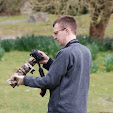Our last full day on Shetland, October 6th, saw us heading back to the north Mainland and Isbister, where a Red-flanked Bluetail had been discovered the day before. Occurrences of this species have taken an up-turn in recent years but it is still an exquisite bird to see in Britain. We arrived in what had become familiar conditions - dull and windy - and checked out the gardens where the bird had been seen. There was precious little in the way of cover, and no sign of the bird.
 |
| Red-flanked Bluetail, Isbister |
 |
| The blue tail on display here... |
 |
| ...plus orangey flanks and a white chin patch |
 |
| Red-flanked Bluetail |
To make matters worse, at this point news filtered through of a Siberian Rubythroat on Bressay the previous day. This, one of the ultimate 'Sibes', was the bird we had all agreed was at the top of our 'most wanted' list on the journey north. Reports suggested that it had been elusive on the Thursday, and that there was no sign of it that morning (Friday). The part we couldn't understand was how it had taken until late morning the following day for news of the sighting to come out at all.
 |
| The local Rock Doves look pretty pure compared to our feral pigeons |
 |
| Raven |
 |
| Highland Cow |
 |
| Starling on the right end of a sheep this time |
One thing I had already come to understand about Shetland was the importance of news being shared promptly, with such a large area to cover, such a relatively small number of birders on the archipelago, and the complexities of travelling between the islands to be overcome. Of course, we didn't know the full circumstances of the find, and there may have been a good explanation, but it was a bit frustrating as we certainly would have wanted to check out Bressay that morning had we known sooner, even if there was only a slim chance of seeing the bird.
 |
| The island of Foula seen from Eshaness |
 |
| Fungi at Eshaness |
 |
| Yellow-browed Warbler from earlier in the day at Hoswick in morning sunshine |
 |
| The team stopped to photograph this cloth sheep sculpture placed randomly on a junction: who needs the Angel of the North? |
We drifted our separate ways muttering darkly, but the black mood was soon broken when a message crackled over the CBs - Howard's razor sharp eyes had re-located the Red-flanked Bluetail. We headed in his direction and were soon enjoying intimate views of a stunning bird, all thoughts of the Siberian Rubythroat forgotten.
 |
| The wild cliffs of Eshaness. A land of... |
 |
| ...dramatic seascapes... |
 |
| ...towering stacks... |
 |
| ...and impossible arches |
After some quality time with the Bluetail, we made the pilgrimage to Eshaness. There was a chance of an American Golden Plover or a Buff-breasted Sandpiper on the short sward of the fields there, but the real attraction was the landscape - dramatic cliffs, stacks and geos being pounded by Atlantic rollers with nothing to stop their advance between us and Newfoundland.
 |
| I had my best opportunity of the trip to study and photograph the Shetland sub-species of Wren at Ollaberry |
 |
| An alert and perky individual |
 |
| The light was low... |
 |
| ...but the views were exceptional |
On the way back south we checked out Ollaberry, where a mystery brown and white bird had been reported by a local resident, but to no avail. A couple of hours later we were back, following up a report of a Coues's Arctic Redpoll. Could this have been the mystery bird? On arrival there was no sign of it - we had a good look around and were on the verge of giving up when a 'snowball' Redpoll flew up from a chicken pen and perched on a wire right in front of Bob and I - it was the Arctic Redpoll. It dropped to some vegetation close to where we stood enabling me to rattle off a few shots. After just a glance at my back-of-the-camera shot, David and Howard expertly re-identified it as a Hornemann's Arctic Redpoll. We watched it with another carload of late-comers until dusk - a great way to end our last evening on Shetland.
 |
| Hornemann's Arctic Redpoll - note the warm buff face... |
 |
| ...large white rump... |
 |
| ...long wings, long tail and narrow flank streaking |
 |
| A large bird compared to the other Redpoll species |
 |
| A relatively small red patch on the forehead is characteristic... |
 |
| ...as are the long white 'trousers' |




























No comments:
Post a Comment